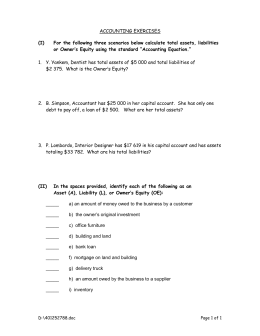Identifying Accounting Practices Study Guide
Posted By admin On 14.01.20- Identifying Accounting Concepts And Practices Study Guide 7
- Part Three-identifying Accounting Concepts And Practices Study Guide 5
The following study guide is meant to help you prepare for the final exam. This material is for your practice and review only. You will not be asked to turn in your responses to the questions and activities below. As you work through these study guides, take note of your confidence level with the material. Ask yourself if you feel comfortable with your grasp of these topics, and take the suggestions for resources to re-watch or re-read seriously before proceeding to the final exam.
The solutions provide step by step illustrated completion. These show the specific content strand that is the focus for the concepts in that unit and serve as a standards checklist. Accelerated geometry review guide #1 multiple choice answers. Each section has a Table of Correlations (yes, you guessed it the CCSS correlations). Instruction for the concepts covered in each section is laid out clearly with two sets of exercises.

Identifying Accounting Concepts And Practices Study Guide 7
For your convenience, Microsoft Word and PDF files of this study guide are linked below. (automatic download). 6a: Identify and analyze accounting transactions of a merchandising company.
Unlike service companies, which do not maintain inventory, merchandising companies will report cost of goods sold on their income statement and report inventory balances on their balance sheet. Inventory transactions often include discounts.
Know how to calculate and record sales and purchase discounts associated with the sale and purchase of inventory. Read about sales and purchase discounts in Hermanson, Edwards, and Maher's Accounting Principles: on pages 304-312. 6b: Define and solve for specific business situations involving various inventory methods.
Part Three-identifying Accounting Concepts And Practices Study Guide 5
The four main methods of tracking inventory costs are FIFO (first-in, first-out), LIFO (last-in, first-out), weighted average, and specific identification. Inventory costs include the purchase price of inventory items as well as the costs associated with getting the items prepared to sell.
What are some of the additional costs that are added to the cost of inventory? Read about inventory costs in Hermanson, Edwards, and Maher's Accounting Principles: on pages 362-386. Unit 6 Vocabulary This vocabulary list includes terms that might help you answer some of the review items above and some terms you should be familiar with to be successful in completing the final exam for the course. Adjunct account Cash discount Consigned goods Cost of goods available for sale Cost of goods sold Delivery expense FOB destination FOB shipping point Gross margin Merchandise in transit Net cost of purchases Net sales Periodic inventory procedure Perpetual inventory procedure Sales allowance Sales return Trade discount Transportation-In account Wholesalers.